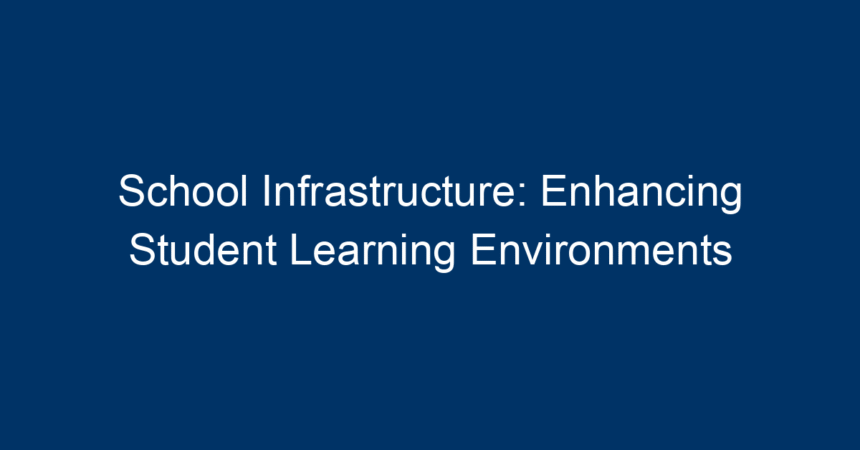In today’s educational landscape, the importance of robust school infrastructure cannot be overstated. As schools evolve into more dynamic environments, the physical spaces where learning occurs are being recognized as pivotal in shaping student experiences and outcomes. This article explores the multifaceted role of school infrastructure in enhancing student learning environments, delving into key elements such as design, technology, safety, and community engagement.
Understanding School Infrastructure
What is School Infrastructure?
At its core, school infrastructure encompasses the physical and organizational structures that support educational activities. This includes school buildings, classrooms, libraries, laboratories, sports facilities, and technology systems. While textbooks and teaching staff are critical, the environment in which education takes place is equally vital.
Why is School Infrastructure Important?
Research highlights a strong correlation between effective school infrastructure and enhanced student performance. Factors such as well-lit classrooms, modern technological tools, and secure environments contribute significantly to student engagement and learning outcomes. A well-designed school infrastructure fosters creativity, collaboration, and critical thinking, effectively preparing students for future challenges.
Key Components of Effective School Infrastructure
1. Classroom Design
The classroom serves as the primary learning space for students, making its design crucial.
Flexible Learning Spaces
Modern classrooms must accommodate various teaching methods. Flexible learning environments that allow for group work, individual learning, and interactive sessions can lead to greater engagement. Movable furniture, varied seating arrangements, and designated areas for collaboration are integral designs.
Daylight and Acoustics
Natural light plays a massive role in enhancing mood and concentration. Classrooms equipped with large windows and good acoustics can significantly reduce distractions, thereby improving focus and productivity.
2. Technology Integration
In today’s digital age, technology is an indispensable part of school infrastructure.
Smart Classrooms
Incorporating smart boards, interactive displays, and virtual learning tools enables educators to create immersive learning experiences. This fosters an environment where students can engage with content in innovative ways.
Wi-Fi Connectivity
Reliable internet access is another cornerstone of modern school infrastructure. It supports research, online learning tools, and communication, significantly enhancing the overall learning experience.
3. Safety and Accessibility
Creating a safe and accessible learning environment is a vital aspect of school infrastructure.
Security Measures
Investing in security systems, including surveillance cameras and controlled entry points, can ensure the safety of students and staff. Moreover, emergency plans must be in place to respond to various situations.
Inclusive Design
Schools must also prioritize accessibility for all students. This includes ensuring that facilities are compliant with the Americans with Disabilities Act (ADA), featuring ramps, elevators, and accessible restrooms.
4. Outdoor Spaces and Facilities
Schools should not overlook outdoor areas as essential components of their infrastructure.
Recreational Areas
Outdoor spaces like playgrounds, sports fields, and gardens provide students with vital opportunities for physical activity and social interaction. These areas promote well-being and contribute to a holistic educational experience.
Green Spaces
Including green spaces not only enriches the aesthetic of the school but also fosters environmental awareness among students. Outdoor classrooms can be used for lessons in biology, ecology, and sustainability.
The Role of Community Engagement
Engaging the community in school infrastructure planning is not just beneficial; it’s essential. Community involvement ensures that the educational environment meets the needs of local students and families.
1. Stakeholder Input
Involving parents, teachers, and community members in infrastructure discussions can lead to solutions that reflect collective values. Surveys and community forums can be instrumental in gathering feedback.
2. Partnerships with Local Organizations
Schools that partner with local businesses and organizations can gain access to resources that enhance their infrastructure. This might include sponsorship for technology grants, donations of materials, or collaborative programs that enrich the curriculum.
Funding and Investment Considerations
Building and maintaining effective school infrastructure requires significant investment.
1. Understanding Funding Sources
Education budgets often include specific allocations for infrastructure, but many schools also rely on grants, donations, and partnerships to fund projects. Understanding these funding sources is essential for any school looking to improve its facilities.
2. Prioritizing Infrastructure Projects
Schools must evaluate which aspects of infrastructure will have the most significant impact on student learning. Prioritizing projects, based on urgency and educational value, can lead to more strategic use of resources.
Actionable Insights for School Administrators
-
Conduct Regular Evaluations: Schools should perform periodic assessments of their infrastructure to identify areas for improvement. Surveys from students, parents, and educators can provide valuable insights.
-
Invest in Professional Development: Training for teachers on utilizing modern technology and flexible classroom layouts can maximize the benefits of upgraded facilities.
-
Foster an Inclusive Culture: Ensure that all students feel represented in the physical space of the school. Artwork, language signage, and cultural representations can create a welcoming environment.
- Develop Long-term Plans: Infrastructure improvements should not be a one-time effort but a continuous commitment. Developing a long-term plan aligns with educational goals and available funding.
Conclusion
The role of school infrastructure in enhancing student learning environments is both significant and transformative. By investing in effective classroom designs, integrating technology, ensuring safety, engaging the community, and strategically planning for the future, schools can create environments that not only support learning but inspire students to achieve their best.
As educators, administrators, and stakeholders, a common goal should be to foster spaces where students feel excited, safe, and empowered. Prioritizing robust school infrastructure is an essential step toward achieving this vision, ultimately allowing for a brighter future for all students. Whether you’re a school leader or a parent, advocating for improved school infrastructure can lead to meaningful changes in the educational experience for our youth.




